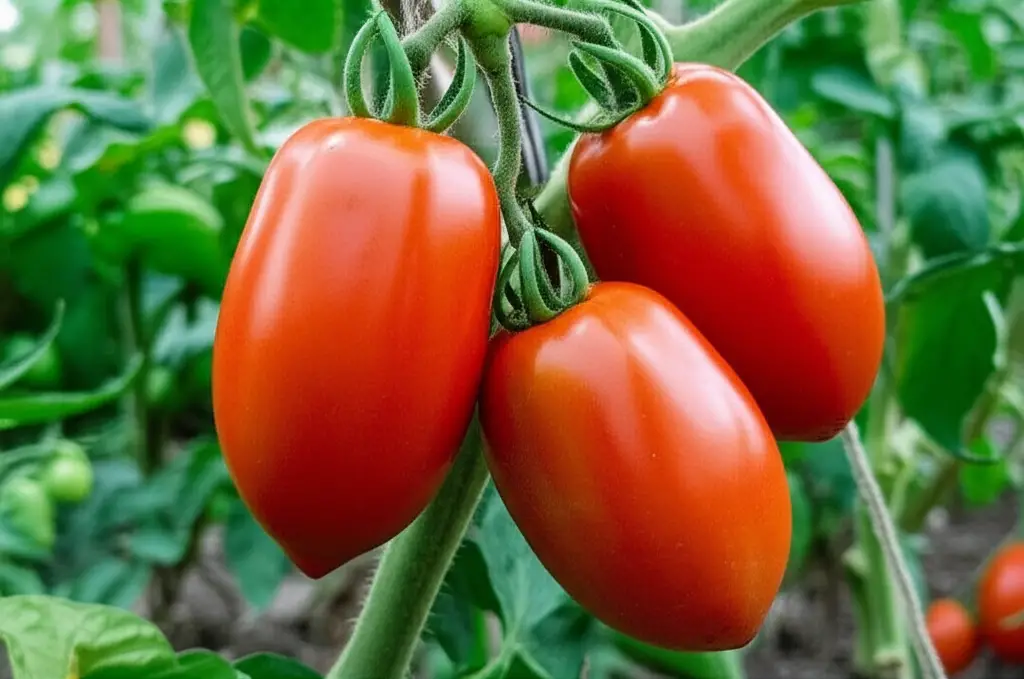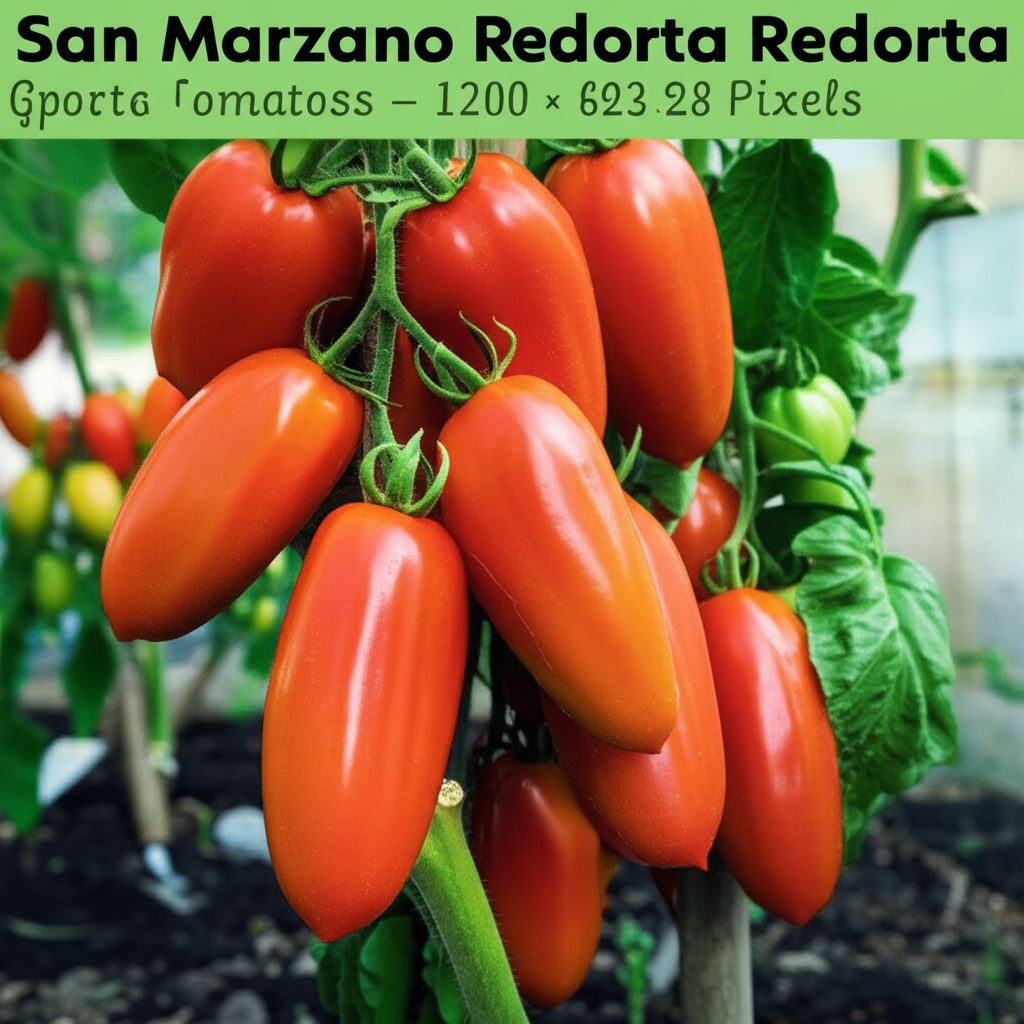This guide provides everything you need to know about cultivating thriving San Marzano Redorta tomato plants, from seed starting to harvest, ensuring a bountiful crop of these prized tomatoes.
The San Marzano Redorta tomato, a slightly sweeter and bushier variation of the classic San Marzano, is a favorite among home gardeners for its rich flavor and prolific production. This comprehensive guide will walk you through every step of growing these delicious tomatoes, providing expert tips and practical advice for success.

JUMP TO TOPIC
Understanding the San Marzano Redorta Tomato
The San Marzano Redorta tomato is a unique variety known for its elongated shape, thick flesh, and low acidity. Compared to the traditional San Marzano, the Redorta variety tends to be slightly sweeter and features a more compact, bushier growth habit, making it ideal for smaller gardens or containers. Its robust flavor makes it perfect for sauces, pastes, and canning, preserving the taste of summer well into the colder months.
Origins and Characteristics
Originating in Italy, the San Marzano tomato has become a staple in Italian cuisine. The Redorta variation offers a slightly adapted version of this classic, retaining the prized characteristics while offering a more manageable plant structure. Key characteristics include:
- Indeterminate Growth Habit: While bushier than the original San Marzano, the Redorta variety still requires staking or support as it continues to grow and produce fruit throughout the season.
- Elongated Fruit: The signature elongated shape of the San Marzano is preserved in the Redorta variety, making it easily recognizable.
- Thick Flesh and Few Seeds: Perfect for sauces and pastes, the Redorta boasts thick, meaty flesh with minimal seeds.
- Rich, Sweet Flavor: A slightly sweeter profile distinguishes the Redorta, adding a nuanced depth to its flavor.
Growing San Marzano Redorta Tomatoes: A Step-by-Step Guide
Starting Seeds Indoors
Begin by starting seeds indoors 6-8 weeks before the last expected frost in your area. Use a seed starting mix and sow seeds about ¼ inch deep. Provide consistent moisture and warmth (70-75°F) for optimal germination.
Transplanting Seedlings
Once seedlings have developed a few true leaves and the threat of frost has passed, transplant them into your garden or containers. Choose a location that receives at least 6-8 hours of sunlight daily.
Soil Preparation and Planting
Prepare the soil by amending with compost or well-rotted manure to enhance drainage and fertility. Space plants about 2-3 feet apart to allow for adequate airflow and growth. Provide support structures like stakes or cages at the time of planting.
Watering and Fertilizing
Water deeply and regularly, especially during periods of hot weather. Avoid overhead watering to prevent fungal diseases. Fertilize every 2-3 weeks with a balanced fertilizer throughout the growing season.
Pruning and Maintenance
Prune suckers that develop between the main stem and branches to encourage upward growth and improve fruit production. Regularly inspect plants for pests and diseases and take appropriate action if necessary.
Harvesting
San Marzano Redorta tomatoes are typically ready for harvest 70-80 days after transplanting. Harvest when fruits are a deep, vibrant red. Gently twist or snip tomatoes from the vine.
Common Pests and Diseases
Like other tomato varieties, San Marzano Redorta can be susceptible to certain pests and diseases. Here are a few common ones to watch out for:
- Blossom-End Rot: Caused by calcium deficiency, this can be prevented by maintaining consistent watering and ensuring adequate calcium in the soil.
- Early Blight: A fungal disease, early blight can be addressed through proper spacing, good air circulation, and preventative fungicide applications if necessary.
- Aphids: These small insects can infest plants. Control them with insecticidal soap or by introducing beneficial insects like ladybugs.
- Tomato Hornworms: These large caterpillars can quickly defoliate plants. Hand-picking them or using a biological insecticide like Bacillus thuringiensis (Bt) can effectively control them.
Tips for Growing Success
- Choose the Right Location: Select a sunny spot with well-drained soil.
- Provide Adequate Support: Staking or caging is crucial for indeterminate varieties like San Marzano Redorta.
- Consistent Watering: Regular and deep watering is essential for optimal growth and fruit production.
- Fertilize Regularly: Provide balanced nutrients throughout the growing season.
- Monitor for Pests and Diseases: Regularly inspect plants and take proactive measures for control.
FAQs About Growing San Marzano Redorta Tomatoes
Q: How long does it take for San Marzano Redorta tomatoes to ripen?
A: San Marzano Redorta tomatoes typically ripen 70-80 days after transplanting.
Q: Can I grow San Marzano Redorta tomatoes in containers?
A: Yes, they can be grown successfully in large containers, provided they receive adequate sunlight and support.
Q: What is the best way to store San Marzano Redorta tomatoes?
A: Store ripe tomatoes at room temperature or in the refrigerator for up to a week. They can also be canned, frozen, or dried for long-term storage.
Q: When should I prune my San Marzano Redorta plants?
A: Prune suckers regularly throughout the growing season to encourage upward growth and improve fruit production.
Delicious Ways to Enjoy San Marzano Redorta Tomatoes
The possibilities are endless when it comes to enjoying your homegrown San Marzano Redorta tomatoes. Their rich flavor shines in classic Italian dishes:
- Homemade Tomato Sauce: The thick flesh and low acidity make them perfect for rich, flavorful sauces.
- Tomato Paste: Create your own concentrated tomato paste for use in various recipes.
- Salads and Bruschetta: Sliced or diced, they add a burst of freshness to summer salads.
- Roasted or Grilled: Roasting or grilling enhances their natural sweetness.
Conclusion
Growing San Marzano Redorta tomato plants is a rewarding experience for any gardener. By following the guidelines outlined in this comprehensive guide, you can cultivate a bountiful crop of these delicious and versatile tomatoes. From understanding their unique characteristics to mastering essential growing techniques, you’re now equipped to enjoy a taste of Italy in your own backyard. Enjoy the journey and the fruits of your labor!

